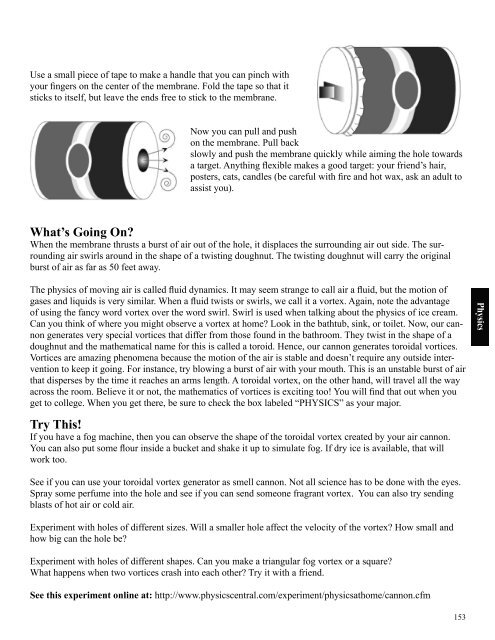ScienceMakers Toolkit Manual - The History Makers
ScienceMakers Toolkit Manual - The History Makers
ScienceMakers Toolkit Manual - The History Makers
Create successful ePaper yourself
Turn your PDF publications into a flip-book with our unique Google optimized e-Paper software.
Use a small piece of tape to make a handle that you can pinch with<br />
your fi ngers on the center of the membrane. Fold the tape so that it<br />
sticks to itself, but leave the ends free to stick to the membrane.<br />
Now you can pull and push<br />
on the membrane. Pull back<br />
slowly and push the membrane quickly while aiming the hole towards<br />
a target. Anything fl exible makes a good target: your friend’s hair,<br />
posters, cats, candles (be careful with fi re and hot wax, ask an adult to<br />
assist you).<br />
What’s Going On?<br />
When the membrane thrusts a burst of air out of the hole, it displaces the surrounding air out side. <strong>The</strong> surrounding<br />
air swirls around in the shape of a twisting doughnut. <strong>The</strong> twisting doughnut will carry the original<br />
burst of air as far as 50 feet away.<br />
<strong>The</strong> physics of moving air is called fl uid dynamics. It may seem strange to call air a fl uid, but the motion of<br />
gases and liquids is very similar. When a fl uid twists or swirls, we call it a vortex. Again, note the advantage<br />
of using the fancy word vortex over the word swirl. Swirl is used when talking about the physics of ice cream.<br />
Can you think of where you might observe a vortex at home? Look in the bathtub, sink, or toilet. Now, our cannon<br />
generates very special vortices that differ from those found in the bathroom. <strong>The</strong>y twist in the shape of a<br />
doughnut and the mathematical name for this is called a toroid. Hence, our cannon generates toroidal vortices.<br />
Vortices are amazing phenomena because the motion of the air is stable and doesn’t require any outside intervention<br />
to keep it going. For instance, try blowing a burst of air with your mouth. This is an unstable burst of air<br />
that disperses by the time it reaches an arms length. A toroidal vortex, on the other hand, will travel all the way<br />
across the room. Believe it or not, the mathematics of vortices is exciting too! You will fi nd that out when you<br />
get to college. When you get there, be sure to check the box labeled “PHYSICS” as your major.<br />
Try This!<br />
If you have a fog machine, then you can observe the shape of the toroidal vortex created by your air cannon.<br />
You can also put some fl our inside a bucket and shake it up to simulate fog. If dry ice is available, that will<br />
work too.<br />
See if you can use your toroidal vortex generator as smell cannon. Not all science has to be done with the eyes.<br />
Spray some perfume into the hole and see if you can send someone fragrant vortex. You can also try sending<br />
blasts of hot air or cold air.<br />
Experiment with holes of different sizes. Will a smaller hole affect the velocity of the vortex? How small and<br />
how big can the hole be?<br />
Experiment with holes of different shapes. Can you make a triangular fog vortex or a square?<br />
What happens when two vortices crash into each other? Try it with a friend.<br />
See this experiment online at: http://www.physicscentral.com/experiment/physicsathome/cannon.cfm<br />
153<br />
Physics










